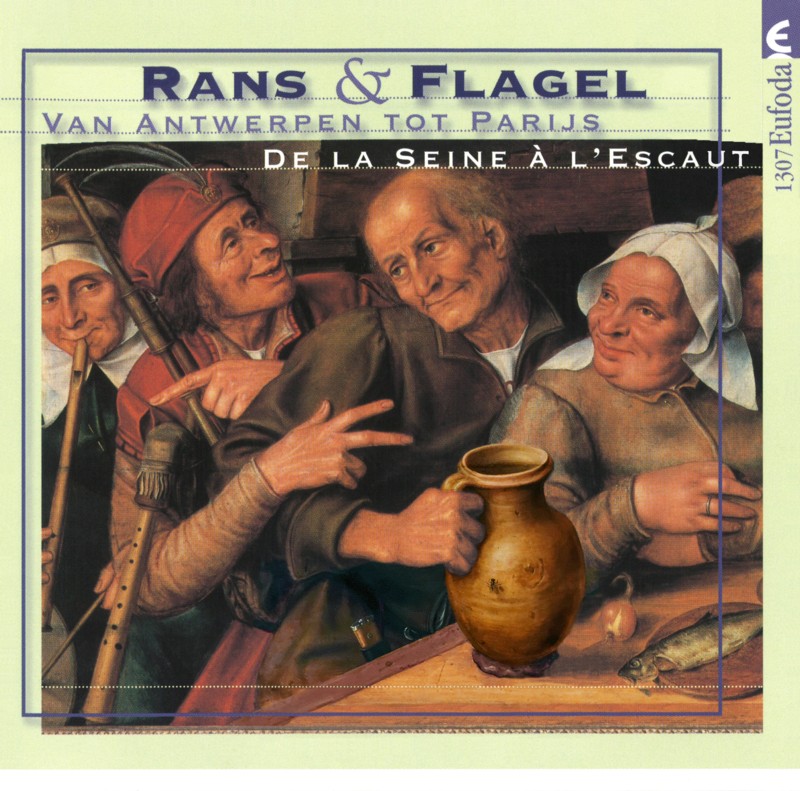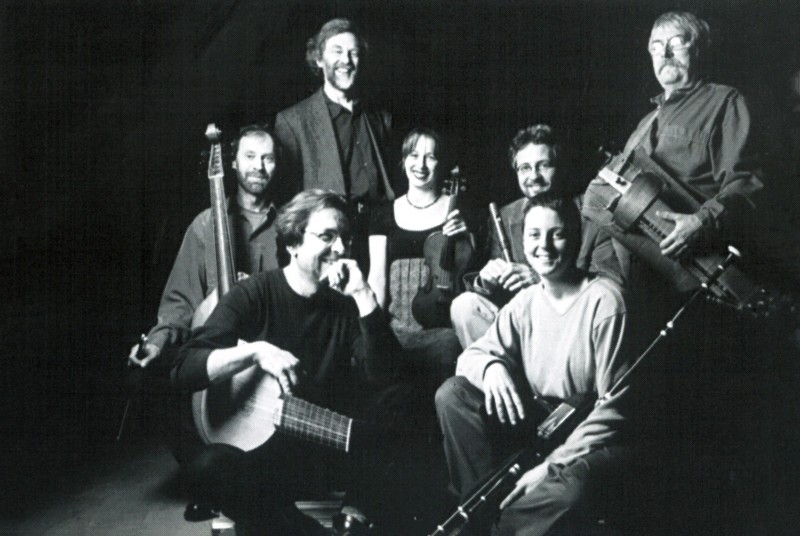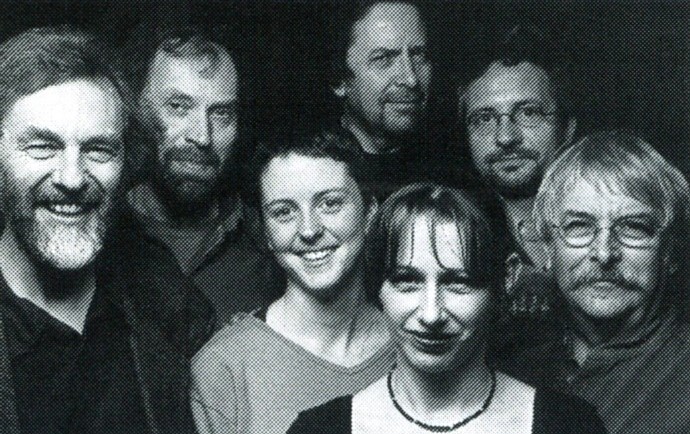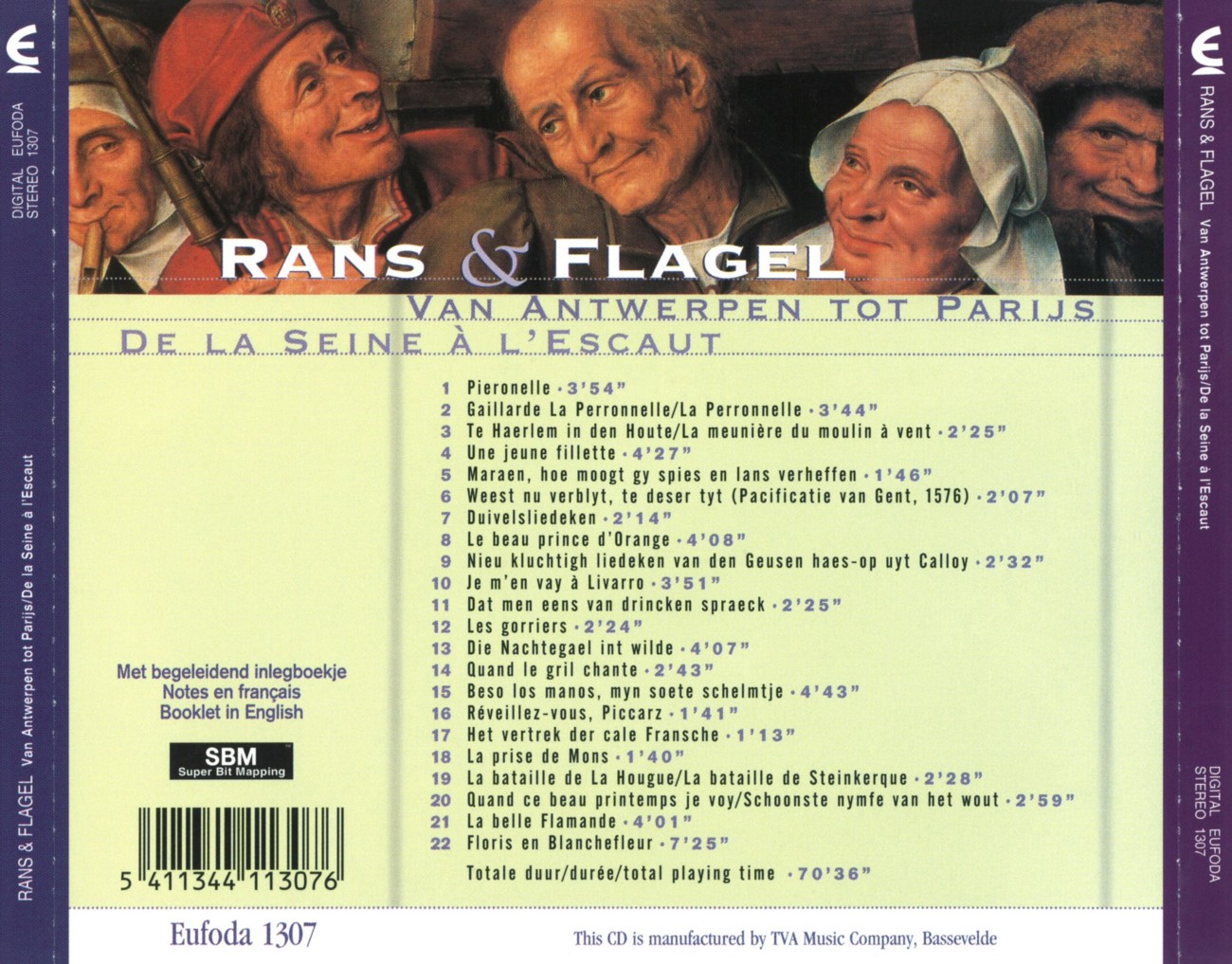
paulrans.com | anz.be
muziekweb.nl | discogs.com
Eufoda 1307
2001
Van Antwerpen tot Parijs / Rans & Flagel
De la Seine à l'Escaut

paulrans.com |
anz.be
muziekweb.nl |
discogs.com
Eufoda 1307
2001
1. Pieronelle [3:54]
2. Gaillarde La Perronnelle/La Perronnelle [3:44]
3. Te Haerlem in den Houte/La meunière du moulin à vent [2:25]
4. Une jeune fillette [4:27]
5. Maraen, hoe moogt gy spies en lans verheffen [1:46]
6. Weest nu verblyt, te deser tyt [2:07] (Pacificatie van Gent, 1576)
7. Duivelsliedeken [2:14]
8. Le beau prince d'Orange [4:08]
9. Nieu kluchtigh liedeken van den Geusen haes-op uyt Calloy [2:32]
10. Je m'en vay à Livarro [3:51]
11. Datmen eens van drincken spraeck [2:25]
12. Les gorriers [2:24]
13. Die Nachtegael int wilde [4:07]
14. Quand le gril chante [2:43]
15. Beso los manos, myn soete schelmtje [4:43]
16. Réveillez-vous, Piccarz [1:41]
17. Het vertrek der cale Fransche [1:13]
18. La prise de Mons [2:40]
19. La bataille de La Hougue/La bataille de Steinkerque [2:28]
20. Quand ce beau printemps je voy/Schoonste nymfe van het wout [2:59]
21. La belle Flamande [4:01]
22. Floris en Blanchefleur [7:25]

PAUL RANS
zang, luit /
voice, lute
CLAUDE FLAGEL
zang, draailier, trom /
voice, hurdy-gurdy, drum
OLLE GERIS
doedelzakken, zang /
bagpipes, voice
PHILIPPE MALFEYT
luit, theorbe, cister, colascione, hakkebord, percussie, zang /
lute, theorbo, cittern, colascione, hammered dulcimer, percussion, voice
PIET STRYCKERS
viola da gamba, barokcello, colascione, zang /
viol, baroque cello, colascione, voice
AN VAN LAETHEM
barokviool, zang /
baroque violin, voice
PAUL VAN LOEY
blokfluiten, dulciaan, zang /
recorders, dulcian, voice

OPNAME EN MONTAGE/ RECORDING AND EDITING:
Sound Recording Centre Steurbaut, Gent
29.6.2001, 1-2.7.2001
SuperBit Mapping
20 bit digital recording on Sony PCM 9000 magnetic optical disc
ARTISTIEKE LEIDING/ PRODUCER: Johan Huys
GRAFISCHE VORMGEVING/ GRAPHIC DESIGNER: Daniël Peetermans
COVERILLUSTRATIE/ COVER ILLUSTRATION:
Jan Massys, Vrolijk gezelschap/ Merry Company
Wien, Kunsthistorisches Museum (foto: AKG Berlin/Erich Lessing)
Foto Rans & Flagel: Björn Tagemose
© 2001 Davidsfonds/Eufoda, Leuven

RANS & FLAGEL
VAN ANTWERPEN TOT PARIJS
DE LA SEINE À L'ESCAUT
Over België wordt graag gezegd
dat dit de plaats is waar de Germaanse en de Latijnse culturen elkaar
ontmoeten. Die wisselwerking tussen noord en zuid, waar vaak dezelfde
thema's in regionale varianten werden bezongen, die Vlaams-Waalse en
Nederlands-Franse voces populi, vormen de rode draad van het programma
dat Claude Flagel en Paul Rans presenteren in Van Antwerpen tot
Parijs/De la Seine à l'Escaut. Overigens ligt de oorsprong van
het repertoire soms ook wel iets verder af dan Parijs of Antwerpen.
Franse of Waalse en Vlaamse of Nederlandse liedjes wisselen elkaar af,
en vullen elkaar aan, begeleid door luit en blokfluit, gamba en viool,
draailier of doedelzak...
Hedendaagse uitvoerders fuseren graag
traditionele muziek en liederen uit verscheidene delen van Europa, of
zelfs uit de hele wereld. Zij versmelten dit repertoire tot wat nu
wereldmuziek heet. Die interactie tussen de verscheidene Europese
culturen heeft echter altijd al bestaan. Een puur, maagdelijk en
ongerept Vlaams (of Duits, Frans, Grieks...) volkslied is niet meer dan
een hersenschim. Wat nog niet wil zeggen dat er geen regionaal karakter
zou bestaan, maar onze gezamenlijke erfenis — zowel uit de
Griekse en Latijnse mythologie als uit het christendom — heeft op
het Europese volkslied een duidelijke stempel gedrukt. Dit Europese
volkslied-repertoire vormt één grote familie, waarin
verwante thema's en motieven bezongen werden (of warden) van
Scandinavië tot Sicilië en van de Oeral tot de Atlantische
Oceaan. Op grote en kleine school. En dus ook van Antwerpen tot Parijs.
De Vlaamse, Nederlandse, Waalse en
Franse liederen op deze cd illustreren hoe het Nederlandse en het
Franse taalgebied muzikaal en thematisch met elkaar zijn verbonden.
Stilistisch reflecteren de uitvoeringen vooral de geest van dit
repertoire, zonder het verleden letterlijk te willen hercreëren,
in een sfeer van Bourgondisch Vlaams tot hoofs Frans en omgekeerd.
It is often said that it is in Belgium that Latin and Germanic cultures
meet. In popular song the cross-fertilisation between North and South,
where similar themes were often sung in their regional versions in
Dutch and in French. These voices of Flemish and Walloon, and Dutch and
French people form the thread that binds together the present programme
offered here by Claude Flagel and Paul Rans. The title Van Antwerpen
tot Parijs/De la Seine à l'Escaut means, 'From Antwerp to
Paris/From the Seine to the Scheldt', but some of the repertoire comes
from either a little further North or further South. French or Walloon
and Flemish or Dutch songs alternate and complement each other,
supported by a variety of instruments — from lute, recorder and
bass viol to bagpipes and hurdy-gurdy.
Today's performers like to borrow traditional music and songs from
various parts of Europe or the world, and to fuse them into what is now
called world music. This is happening on a large scale, but there is in
fact nothing new in European cultures interacting and fertilising each
other. A pure and unadulterated Flemish (or French, German, Greek...)
folk song does not really exist. This does not mean of course that
there isn't such a thing as regional character, but our common heritage
from Greek and Latin mythology and from Christianity has left its mark
on European folk songs. They are part of one big family with themes and
motifs that run from Scandinavia to Sicily, and from the Ural Mountains
to the Atlantic Ocean. And from Antwerp to Paris.
The present programme shows a small part of this common heritage in a
repertoire of Flemish, Dutch, Walloon and French songs that are linked
musically and thematically. Stylistically the interpretations reflect
the spirit of this repertoire, rather than trying to produce literal
recreations of the post, and evoke an atmosphere that changes from
festive Flemish to courtly French and vice-versa.
1. Pieronelle
Haerlems Oudt Liedt-boeck, Haarlem, 1716 (stem: Ey, wilder dan wilt)/
Souterliedekens ghemaect ter eeren Gods, op alle die psalmen van David,
Antwerpen, 1540 ('na de wijse Roosken root, seer wijdt ontloken')/
Jan Fruytiers, Ecclesiasticus, Antwerpen, 1565, nr. 53 ('op die wijse Och roosken root')/
Jan Frans Willems, Oude Vlaemsche Liederen, Gent, 1848, nr. 106/
Florimond van Duyse, Het Oude Nederlandsche Lied, Antwerpen-Den Haag, 1903-1905, nr. 290/
Arr. Piet Stryckers
Pieronelle, a Flemish girl, is lured away by three frenchmen. Her three
brothers organise a search for her, but when they finally find her she
refuses to go back home. There she would have to suffer the disgrace of
having lost her honour and she prefers life with the frenchmen who have
a taste for good living and good wine.
2. Gaillarde La Perronnelle/La Perronnelle
Chorearum Molliorum, Antwerpen, 1583/
Paris, Bibliothèque nationale, ms. fr. 12.744/
Gaston Paris & Auguste Gevaert, Chansons du XVe siècle, Paris, 1875
In the French version Perronnelle is taken away by three gendarmes,
dressing her like a page-boy to take her out of the country. Her three
brothers find her eventually by a fountain and ask her to come home
with them, but she refuses to go back to France whilst, like the
Flemish girl, giving her fond regards to her parents. The popularity of
this French song is reflected in the galliard which Pierre
Phalèse published in Antwerp in 1583.
3. Te Haerlem in den Houte/La meunière du moulin à vent
Amsterdamsche Vreughde-Stroom, Amsterdam, 1655/
Luitboek van Thysius, 1621-1653. Leiden, Universiteitsbibliotheek, hs. hys. 1666/
Florimond van Duyse, Het Oude Nederlandsche Lied, Antwerpen-Den Haag, 1903-1905, nr. 281/
Arr. Piet Stryckers —
Léonard Terry & Léopold Chaumont, Recueil d'airs de
cramignons et de chansons populaires à Liège,
Liège, 1889/
Albert Boone, Het Vlaamse volkslied in Europa, Tielt, 2000
Millers have always had a reputation as being ladies' men. In the Dutch
song the miller plans to serve wine to a girl's mother, hoping he'll be
able to take her daughter unnoticed to his bedroom. In the French song
a miller girl rebuts the advances of young colin, too worried about the
village gossips. The tune is obviously popular but the text may have a
more literary origin, although the refrain 'Par derrière et par
devant' occurs regularly in ribald songs from the 16th century to today.
4. Une jeune fillette
Jehan Chardavoine, Le recueil des plus excellentes chansons en forme de voix de ville, Paris, 1576
A young woman is forced to enter a convent, where she longs for her
lover. This unhappy theme was very popular and this version by
Chardavoine is the most complete. Five of the seven verses are sung
here. The tune was also used as a dance, Allemande Nonette, borrowed in
France for a Christmas carol which is still sung today. In the Low
Countries the tune was used for a song against the Spanish occupation
in the 16th and 17th centuries, Maraen, which follows the French
version here.
5. Maraen, hoe moogt gy spies en lans verheffen
Adriaen Valerius, Nederlandtsche Gedenck-Clanck, Amsterdam, 1626 (stem: Almande Nonette/Une jeune fillette)
'Maraen' was a word to designate the Spanish occupiers who, among other
injustices, forced the infamous Inquisition on the population. The
'geuzen' (literally 'beggars' but they carried the name with aride)
revolted against Spain and Catholicism and 'geuzen-songs' played an
important part in this historic fight which ended with the Netherlands
becoming independent and Protestant, whilst Flanders remained Catholic
under the rule of the Habsburgs. This song accuses the Spanish of
thinking that
they are above God, who is the true ruler of the world.
6. Weest nu verblyt, te deser tyt
(Pacificatie van Gent, 1576)
In November 1576 the Seventeen Provinces agreed to remain united in
eternal peace, getting rid of ail foreign troops. Catholicism remained
the official religion, except in Holland and Zealand where there was to
be freedom of religion under William of Orange. This song celebrates
this agreement, known as the Pacification of Ghent, and reflects the
brief feelings of hope and happiness — soon to be dashed.
7. Duivelsliedeken
Abraham Verhoeven, Den tocht van de Brandt-stichters, Antwerpen, 1622 (stem: Guillelmus van Nassouwe)
In May 1622 Frederic Henry of Nassau and
his troops looted and burned down great parts of the province of
Brabant. This song — a pamphlet from Antwerp — is against
the 'geuzen', satirising the cruelty and hypocrisy of so-called
God-fearing men in the dutch army. This is done to the tune of the
Wilhelmus, which became the Dutch national anthem, but here in a
ternary rather than the usual binary time.
8. Le beau prince d'Orange
Paris, Bibliothèque nationale, ms. fr. 12.666/
Arr. Piet Stryckers
The death of René of Nassau, the 'handsome prince of Orange',
who fought with Charles V against the French king François I. An
eye-witness brings a letter describing how he was killed in the battle
of Saint-Dizier (1544) and subsequently buried — a scene
reminiscent of that famous song Malbrouck s'en va-t-en guerre, but
preceding it by two centuries. The French did not like this handsome
prince and made it clear in the derisory tone of the song.
9. Nieu kluchtigh liedeken van den Geusen haes-op uyt Calloy
Maurits Sabbe, Brabant in 't verweer, Antwerpen, 1931 (stem: Hebbense dat gedaen, doense, doense...)
This is a second song against the 'geuzen' who suffered a serious defeat
in Kallo on the river Scheldt in 1638. The Dutch had found an ally in
France to attack the Spanish in Flanders, but this was to no avail as
the Spanish troops managed to fight back the Dutch. Prince William of
Nassau's son was killed in the battle. This was to the taste of
pro-Catholic Flemings who satirised the 'geuzen' in this text set to a
well-known traditional Flemish tune.
10. Je m'en vay à Livarro
Jacques Mangeant, Recueil des plus belles chansons des comédiens françois, Caen, 1615
A very French drinking song with a tune that invites the singer (and
the piper) to let the voice reach high and far. Even in France eating
and drinking well was often associated with the vision of Flemish
feasts as depicted by Brueghel, Teniers, Van Ostade or Jan massjis (see
CD cover). Bacchanals such as this one make up about half of the songs
in Jacques Mangeant's collection of 1615.
11. Datmen eens van drincken spraeck
Jan Jansz. Starter, De Friesche Lusthof, Amsterdam, 1621
Drinking songs were as popular in the Low Countries as in France, and
this song — written in the style of chambers of rhetoric —
extols the benefits of drinking good wine (especially French) such as
making people talk, dance and sing: farewell wisdom, see you in the
morning.
12. Les gorriers
Paris, Bibliothèque nationale, ms. fr. 12.744/
Gaston Paris & Auguste Gevaert, Chansons du XVe siècle, Paris, 1875/
Arr. Piet Stryckers
In late 15th century Paris 'gorriers' were trendy young people who
liked to live in style but who lacked the means to do so. Gaston Paris
and Auguste Gevaert's research resulted in the publication of 143 songs
that were popular in France at the end of the 15th century. For many of
these songs this is the only source.
13. Die Nachtegael int wilde
Een Aemstelredams Amoreus Lietboeck, Amsterdam, 1589 ('op de voys Brande Matresse')/
Luitboek van Thysius, 1621-1653. Leiden, Universiteitsbibliotheek, hs. Thys. 1666
A bilingual song, in Dutch but with a French chorus, set to a 'Brand'
or branle, one of the most popular French dances. The wording and the
story itself are wholly permeated by Frenchness: a lover pleads for his
lady to return his feelings, her heart is already taken, but — as
he threatens to take his life — she doesn't want to be ungenerous
and welcomes him as
well. Even if the pope was her father she would not forego the love of this faithful servant.
14. Quand le gril chante
Jehan Chardavoine, Le recueil des plus excellentes chansons en forme de voix de ville, Paris, 1576
This is a typical 'air de cour' which, supported by the lute, evokes an
idealised life of rural bliss. It cames from a collection of 153 songs
published in 1576 by Jehan Chardavoine. Many of these songs were not
only pleasant to listen to but also very suitable for dancing.
15. Beso los manos, myn soete schelmtje
Jan Jansz. Starter, De Friesche Lusthof, Amsterdam, 1621
A satirical song about the enthusiasm with which all nations keep going
to war, always to the detriment of the pensants. This is one of
Starter's coarse songs, the 'boertigheden' at the end of his Friesche
Lusthof. Jan Jansz Starter was of English descent, a 'minor poet' but
an excellent songwriter who liked to borrow tunes from other European
countries, including
England, Flanders and France. Of the eight verses six are sung here.
16. Réveillez-vous, Piccarz
Paris, Bibliothèque nationale, ms. fr. 12.744/
Gaston Paris & Auguste Gevaert, Chansons du XVe siècle, Paris, 1875
This song evokes the wars at the time of emperor Maximilian of Austria,
who opposed the kings of France as well as the Flemish towns until
1489. Wake up citizens of picardy and burgundy, it's time to go to war,
a sad state of affairs. The
duke of Austria is in the Low Countries, in Flanders with his Picards
who want to conquer Burgundy for him. Farewell Besançon and
Beaune, home of good wine. The Picards have drunk it and the Flemish
will have to pay. If they refuse they will be beaten up.
17. Het vertrek der cale Fransche
Ms. Di Martinelli, Diest, ca. 1743-1770 (P206). Leuven, Katholieke Universiteit/
Arr. Piet Stryckers
18. La prise de Mons
Paris, Bibliothèque nationale, ms. fr. 12.669 ('timbre Nous
voyageons parmi le monde')
The end of the 17th century was marked by the wars between France under
Louis XIV and the Augsburg League which was joined by the Low Countries
and England. The siege of Mons (in Wallonia) and the bombing of
Brussels which destroyed part of the Grand' Place are just two of the
many violent events of those years.
19. La bataille de La Hougue/La bataille de Steinkerque
Paris, Bibliothèque nationale, ms. fr. 12.670 ('timbres La petite fronde/Les Rochellois')/
Arr. Piet Stryckers
Two defeats suffered by the French army in 1692, one at sea near La
Hougue, the other on land at Steinkerque (Steenkerke in the province of
Brabant). Both battles left many people dead, with winners and losers
exhausted and the singer complaining that too many glorious battles end
with funeral music.
20. Quand ce beau printemps je voy/Schoonste nymfe van het wout
Jehan Chardavoine, Le recueil des plus excellentes chansons en forme de voix de ville, Paris, 1576/
Den Bloemhof van de nederlantsche ieucht, Amsterdam, 1608 ('voys Bella nympha fugitiva')/
Florimond van Duyse, Het Oude Nederlandsche Lied, Antwerpen-Den Haag, 1903-1905, nr. 130
'Quand ce beau printemps je voy' (When I see this beautiful springtime)
is a poem by Pierre de Ronsard which was included in Adrien le Roy's
Airs de Cour (1571). The tune proved so popular that many contrafacta
were made in French, Dutch, German and Italian, setting it to bucolic,
political and even religious lyrics. There is a political Dutch
'geuzen-song', but this version dwells in the same pastoral spheres as
the original and is sung alternately with the french, to a slightly
different tune.
21. La belle Flamande
Patrice Coireault, Formation de nos chansons folkloriques, Paris, 1959
The French campaigns in Flanders consisted not only of battles. For the
French soldiers the wealth of the Flemish regions was often like a
vision of the land of Cockaigne. The beautiful Flemish girl of this
song has so many lovers that she doesn't know which one to choose and
the same proverbial girl features in numerous songs which became
popular throughout France.
22. Floris en Blanchefleur
Edmond de Coussemaker, Chants populaires des Flamands de France, Gent, 1856, nr. 51/
Arr. Piet Stryckers
The origin of this ballad is a medieval french poem, Flore et
Blanchefleur. This version was transmitted orally and collected by
Edmond de Coussemaker in the middle of the 19th century in French
Flanders (Northern France, formerly part of the Low Countries, where
older people still speak a Flemish dialect). Blanchefleur is not
allowed to marry the king's son and is sold to the Turkish emperor,
while her beloved Floris is told that she has died. He
finds out that she is alive and travels to Turkey where he manages to
find a way inside the palace, hiding in a basket which is pulled up with
a rope by Blanchefleur. He enters her room, they fall into each other's
arms and spend the night together. In the middle of the night the
emperor enters the bedroom and wants to kill them both, but they plead
for forgiveness. The emperor holds back, forgives them and lets them be
married in church which, after 19 verses (here somewhat shortened), is
a suitably happy end.
